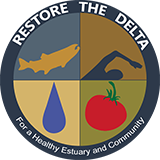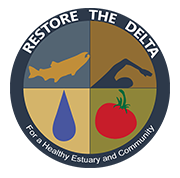Yet, another water bond
Restore the Delta has been working on so many issues this year that we have not weighed in with our members on Proposition 3, the $8.9 billion dollar water bond, on the November ballot. Additionally, we did not open a PAC and lead an opposition campaign opposing Prop 3, as we did against Prop 1 in 2014, because we knew that even if we could raise the money, we didn’t have the mental/physical/spiritual bandwidth to lead an opposition campaign on top of all the other work we have undertaken this year in our advocacy to stop the Delta tunnels, and to ensure that adequate flows are restored to the Delta estuary, for all Delta communities.
We can, however, make a statement evaluating Prop 3. So here we go!
We don’t like it! We really, really don’t like it — despite the fact that it does contain some needed dollars to help communities with serious water needs in the San Joaquin Valley – which makes not liking it problematic. But we still don’t like it.
Our first problem is that the percentage of money allocated in the $8.9 billion dollars to help with environmental justice water community needs is a pittance. It is about 10% of the overall bond. This is the problem we see time and time again with water resource management in California. About 90% of funding in water project management goes to fund special interest water districts, industrial agriculture, and speculative developers looking for new water supplies. The projects that are needed to solve serious drinking water problems for environmental justice communities in all of California, to create regional self-sufficiency to lessen dependence on the Delta, and to protect existing water supplies, rivers, and watersheds like the Delta, continue to be grossly underfunded. To read more about these funding inequities, click here to read an excellent op-ed by Eric Parfrey, Chair of Sierra Club California.
We understand why certain groups would support this bond for water challenged communities within their service areas. We get it and empathize fully. But we believe that perpetuating a water bond scheme that favors a small percentage of special interests without rebuilding California’s water system to favor 98% of water users just doesn’t work any longer. We have had 30 years of that scenario, and water management outcomes are not improving.
Second, the money in Prop 3 marked for Delta restoration is tied to the construction of the Delta tunnels. It contains mitigation money for projects that water exporters are supposed to pay for to correct problems from over exporting water over the last 30 years. And it’s packed with funding for restoration projects that will not work with construction and operation of the fresh-water-depleting Delta tunnels. As long as adequate flows do not pass through the Delta to nourish the estuary, either from tunnel operations, over pumping at the current facilities, or inadequate flow releases, restoration projects will fall short to accomplish their promised goals. Why should voters throw good money after bad decision making?
Third, subsidence from groundwater pumping in the South San Joaquin Valley is what has caused the Friant-Kern canal to sink and to require expensive repairs. Taxpayers should not be on the hook for the needed $700 million in repairs to fix and expand the Friant-Kern Canal as earmarked in Prop 3 after big growers damaged their own groundwater system.
Don’t be fooled. The push to expand the capacity of Friant-Kern Canal and related facilities to move water around links up to plans for Kern County Water Agency to receive additional water exports from the Delta tunnels. Kern County interests want lots of new water for their desert communities from other parts of the state in order to become the proverbial oasis in the desert, sort of like Palm Springs. Remember, Kern County Water Agency, is set to contribute only about 21% of Delta tunnels funding, as the project will primarily be funded by Metropolitan Water District customers, yet KCWA maintains that their export allotments will increase dramatically. Meanwhile, Southern California environmental justice communities will be subsidizing big ag through higher water rates and property taxes for the tunnels, and, through Prop 3, will be subsidizing big ag infrastructure, while groundwater supplies in Southeast Los Angeles County remain polluted, and regional self-sufficiency water projects remain on the back burner.
Water quality planning process for the Delta
It has come to our attention that some who oppose the Delta tunnels are making arguments that additional flows should not be allotted for the estuary because “flows” will enable construction of the Delta tunnels. (In fact, Congressman Jeff Denham, whose district touches the South Delta, has been making this argument to our members. Never mind he voted for the Calvert and Valadao riders to override due process rights for potential Delta litigation against the tunnels. We will save that story for another upcoming newsletter.)
At Restore the Delta, we see Congressman Denham’s logic as something akin to the following:
A person sees into the future and knows she will be murdered. Thus, she chooses to starve herself to death so that she won’t be murdered.
To be clear, as we have written in each and every comment letter during the Bay-Delta Water Quality Plan update process, and in our recently released report The Fate of the Delta, the first problem is that there is not a measurable set of standards to ensure that new flows move through the Delta and to the San Francisco Bay. This is necessary so that the public knows that flows are being used to restore and nourish the estuary for all its beneficial uses, from drinking water supplies to healing fisheries, and protecting Delta agriculture. We believe that all water users (agricultural, municipal, industrial) from the top to the bottom of the San Joaquin River watershed should contribute a bit of water in a fair and equitable manner to save the estuary. We believe in shared sacrifice – not in a less than honest scheme to export even more water from our rivers to water exporters. This is one reason why we oppose the Bay-Delta Water Quality Plan as written.
Second, we maintain that increased flows will improve water quality in the South Delta. The present salinity standard needs to be enforced, rather than weakened as currently proposed by the State Water Resources Control Board.
Third, flows must be increased to restore fisheries, and to protect water quality for all its beneficial uses, including drinking water supplies. Because water temperatures are set to increase with climate change, flow is a necessity to combat a proliferation of toxic algal blooms. The minimum needed is 50% outflow from the San Joaquin River.
We know that California WaterFix, sooner or later, will die in this iteration, with or without litigation. The Delta, however, without adequate inflows and outflows will not survive another twenty years. If we are to save the estuary, and restore the Delta, as our name claims, protecting water quality and quantity to make the Delta fishable, swimmable, drinkable, and farmable is as important as stopping the tunnels.
For years, we have made it clear what we are against, the tunnels. We are, however, equally proud of what we are for – a restored San Francisco Bay-Delta estuary that will serve the public trust and public interest for generations to come. In some ways, even in this David and Goliath fight, it is easier to be against something bad, than it is to work to achieve something for the greater good. Our question: Who has the heart, courage, and vision to fight for a restored Delta with us for future generations?

